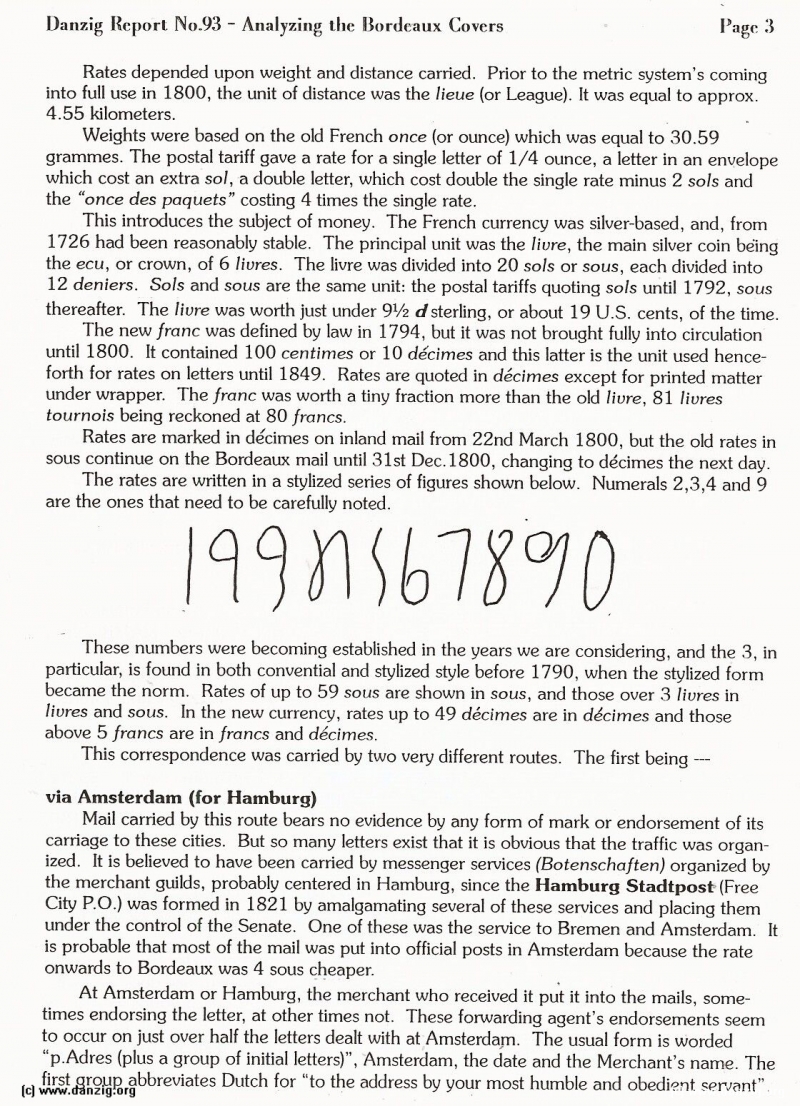
Rates depended upon weight and distance carried. Prior to the metric system’s coming into full use in 1800, the unit of distance was the lieue (or League). It was equal to approx. 4.55 kilometers.
Weights were based on the old French once (or ounce) which was equal to 30.59 grammes. The postal tariff gave a rate for a single letter of 1/4 ounce, a letter in an envelope which cost an extra so!, a double letter, which cost double the single rate minus 2 sols and the “once des paquets” costing 4 times the single rate.
This introduces the subject of money. The French currency was silver-based, and, from 1726 had been reasonably stable. The principal unit was the livre, the main silver coin being the ecu, or crown, of 6 liures. The hivre was divided into 20 sols or sous, each divided into 12 deniers. Sols and sous are the same unit: the postal tariffs quoting sols until 1792, sous thereafter. The liure was worth just under 91/2 dsterling, or about 19 u.s. cents, of the time.
The new franc was defined by law in 1794, but it was not brought fully into circulation until 1800. It contained 100 centimes or 10 de’cimes and this latter is the unit used hencef orth for rates on letters until 1849. Rates are quoted in d&imes except for printed matter under wrapper. The franc was worth a tiny fraction more than the old livre, 81 livres tournois being reckoned at 80 francs.
Rates are marked in dcimes on inland mail from 22nd March 1800, but the old rates in sous continue on the Bordeaux mail until 31st Dec. 1800, changing to d&imes the next day.
The rates are written in a stylized series of figures shown below. Numerals 2,3,4 and 9 are the ones that need to be carefully noted.
These numbers were becoming established in the years we are considering, and the 3, in particular, is found in both convential and stylized style before 1790, when the stylized form became the norm. Rates of up to 59 sous are shown in sous, and those over 3 livres in livres and sous. In the new currency, rates up to 49 décimes are in dcimes and those above 5 francs are in francs and dcimes.
This correspondence was carried by two very different routes. The first being
via Amsterdam (for Hamburg)
Mail carried by this route bears no evidence by any form of mark or endorsement of its carriage to these cities. But so many letters exist that it is obvious that the traffic was organi zed. It is believed to have been carried by messenger services (Botenschaften) organized by the merchant guilds, probably centered in Hamburg, since the Hamburg Stadtpost (Free City P.O.) was formed in 1821 by amalgamating several of these services and placing them under the control of the Senate. One of these was the service to Bremen and Amsterdam. It is probable that most of the mail was put into official posts in Amsterdam because the rate onwards to Bordeaux was 4 sous cheaper.
At Amsterdam or Hamburg, the merchant who received it put it into the mails, somet imes endorsing the letter, at other times not. These forwarding agent’s endorsements seem to occur on just over half the letters dealt with at Amsterdam. The usual form is worded “p.Adres (plus a group of initial letters)”, Amsterdam, the date and the Merchant’s name. The first group abbreviates Dutch for “to the address by your most humble and obedient servant”.
Danzig Report Vol. 1 - Nr. 93 - October - November - December - 1996, Page 3.
Hits: 3602
Added: 19/07/2015
Copyright: 2025 Danzig.org

